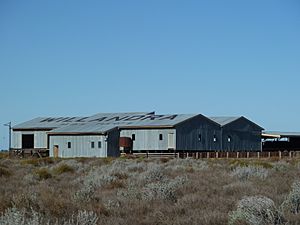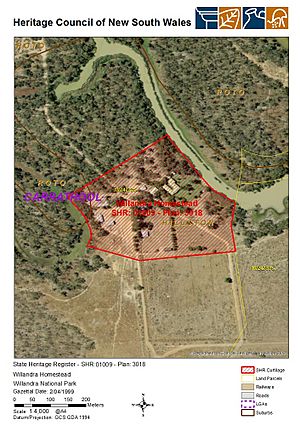Willandra Homestead facts for kids
Quick facts for kids Willandra Homestead |
|
|---|---|

Willandra shearing shed
|
|
| Location | Willandra National Park, Carrathool Shire, New South Wales, Australia |
| Built | 1918–1918 |
| Architect | Laird & Buchan |
| Owner | Office of Environment and Heritage |
| Official name: Willandra Homestead | |
| Type | state heritage (built) |
| Designated | 2 April 1999 |
| Reference no. | 1009 |
| Type | Homestead building |
| Category | Residential buildings (private) |
| Builders | Frederick Coulson |
| Lua error in Module:Location_map at line 420: attempt to index field 'wikibase' (a nil value). | |
Willandra Homestead is a special old house located in Willandra National Park, New South Wales, Australia. It was designed by Laird & Buchan and built in 1918 by Frederick Coulson. Today, the New South Wales Office of Environment and Heritage looks after it. This homestead is so important that it was added to the New South Wales State Heritage Register on April 2, 1999.
Contents
A Look Back at Willandra Homestead
Early Days of Willandra Station
Willandra Homestead was once the main house of a huge sheep property called Willandra Station. This property was started in the 1880s by two partners, Whittingham and Haynes. It was incredibly large, covering about 736,000 acres. That's bigger than many cities!
During the 1890s, there were big disagreements between sheep shearers and property owners. Shearers at Willandra reportedly stood up for their new union in 1890. This time is even mentioned in an old Australian folk song called "Flash Jack from Gundagai."
New Owners and Big Changes
Later, the London Bank of Australia owned the property. In 1912, it was sold to two farming families, the Fields and Vickerys. Under their care, Willandra became one of Australia's largest stud merino stations. This means they focused on breeding very special merino sheep. They had more than 90,000 sheep on the property!
The homestead you see today was built in 1918. It was made using some of the first asbestos fibrous cement sheeting produced in Australia.
The original shearing shed, which was huge with 83 shearing stands, burned down. It was replaced by a much smaller shed with only 12 stands.
From Private Property to National Park
In the 1950s, the New Zealand Land Company bought the property. Then, in 1960, it was sold again to Dalgety & Company.
The Willandra National Park was created in May 1972. It covered 13,000 acres of land. However, the homestead area was not part of the park at first. In 1974, Dalgety decided to sell the part of the property that included the homestead.
A company called Boral bought about 6,000 acres, including the homestead and shearing areas. They paid $100,000 for it. Boral then generously donated this land to the National Parks and Wildlife Service. They also gave $30,000 to help set up the new park.
After the homestead was handed over, its future was uncertain. In 1977, it was described as empty and in bad shape. But in the late 1970s and 1980s, work began to make it stable. Between 1996 and 2001, the homestead and shearing areas were fully restored.
Today, the homestead complex is used as a place for tourists to stay. You can even stay in the main homestead, a cottage, or the old men's quarters.
What Willandra Homestead Looks Like
The Willandra Homestead buildings are still standing strong within the Willandra National Park.
The Main Homestead Building
The main homestead was built in 1918. It has 26 rooms and is made of weatherboard. The building is shaped like a "U" around a central open area, and it has verandahs all around.
Other Buildings at the Homestead
The homestead complex also includes several other old buildings. These include the jackaroos quarters from 1918, a ram shed built in 1933, and cottages from the 1940s.
The shearing area has its own buildings. These include the shearers' quarters, a cook house, and the overseers' cottage, all built in 1936. The rebuilt shearing shed dates from 1960.
How the Buildings Are Used Today
The main house is now used for fancy accommodation for visitors. You can also find less expensive places to stay on the property.
Some of the other buildings are used by staff and for managing the park. These include the overseers' cottage, parts of the jackaroo's quarters, the workshop, stables, and garage.
Why Willandra Homestead is Special
Willandra Homestead is very important to the state of New South Wales. It's a rare and complete example of a country house that shows modern architectural ideas from its time. The famous Victorian architects Laird and Buchan designed it.
The building is a modern take on a rural homestead. It was built with the newest materials and simple decorations popular back then. The homestead shows the hopes of the Willandra Pastoral Company and their positive outlook after World War One. It is the main part of the homestead area, set in a well-planned landscape. It also has other buildings, gardens, and fun areas around it.
Willandra Homestead was officially added to the New South Wales State Heritage Register on April 2, 1999.


